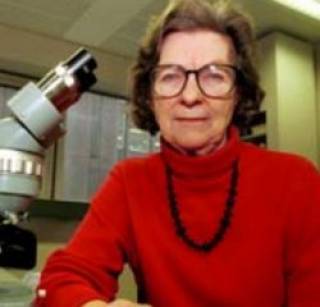From 2016, the annual UCL student award for academic excellence for the MSc in Reproductive Science and Women’s Health will be known as the Anne McLaren Award.

She obtained her D Phil in 1952 and continued to work at UCL. One of Anne’s earliest experiments with John Biggers demonstrated that mammalian embryos cultured outside of the womb for over 24 hours would result in a normal birth – a key discovery leading to the first successful clinical application of IVF some 20 years later.
With the arrival of her three children in the 50s, she often brought them to the lab and showed how a woman could juggle motherhood and a scientific career. She moved to Edinburgh in 1959 and became a single parent. Anne was active throughout her professional life in support of the advancement of women in science and amongst other roles she was a founder of the Association of Women in Science and Engineering (AWiSE), and it’s President for many years.
In 1967, Anne received her first major scientific award - the Zoological Society of London Scientific Medal in recognition of her ‚far ranging investigation into the physiology of reproduction in mammal’. This included not only the factors underlying changes in performance with increasing maternal age, but also the influence of the environment on the growth and development of embryos. The award, for distinguished work by a scientist under 40 years of age in the zoological sciences, also recognized Anne’s leading role in the development of techniques to permit the transfer of blastocysts into the uterine horns of recipient mice, citing specifically “her meticulous analysis of the factors which must be controlled if transfers are to be successful [that] was a major factor in stimulating the use of the method in laboratories in many parts of the world”. Her experiments were praised as ‚elegantly designed to provide unambiguous answers’ to the problems they set out to solve.
After being in Edinburgh for 15 years she returned to UCL to the new MRC-funded Mammalian Development Unit, of which she was appointed the founding Director in 1974. She ran the unit for almost 20 years. Anne moved to Cambridge to the Wellcome Cancer Research Centre, later to become the Wellcome Trust/Cancer Research UK Gurdon Institute. Continuing her studies into the development of primordial germ cells as head of one of the Gurdon laboratories.
Anne was the recipient of innumerable awards and honors, and held positions of highest office across a wide range of fields across her career of more than half a century. As Founding Director of the Medical Research Council (MRC) Mammalian Development Unit in London (UCL 1974–1992), Fellow of the Royal Society (FRS 1975), Fellow of the Royal College of Obstetricians and Gynecologists (1986), Fullerian Professor of Physiology at the Royal Institution (1990–1995), President of the British Association for the Advancement of Science (1993–1994), Fellow of the Academy of Medical Sciences (1998), and recipient of the prestigious March of Dimes and Japan Prizes (2002 and 2007), Anne’s contribution to medicine and the life sciences was simply huge. In 1993 she was created a Dame Commander of the British Empire (DBE).
Famously she was the first woman to hold office in the 330 year history of the Royal Society, becoming its Foreign Secretary in 1991 (to 1996), and a year later its Vice President (1992–1996).
Anne was one of the most eminent and highly respected reproductive biologists of the twentieth century. She died in 2007, aged 80.
Text derived from Anne’s obituary, written by Professor Sarah Franklin.
 Close
Close

